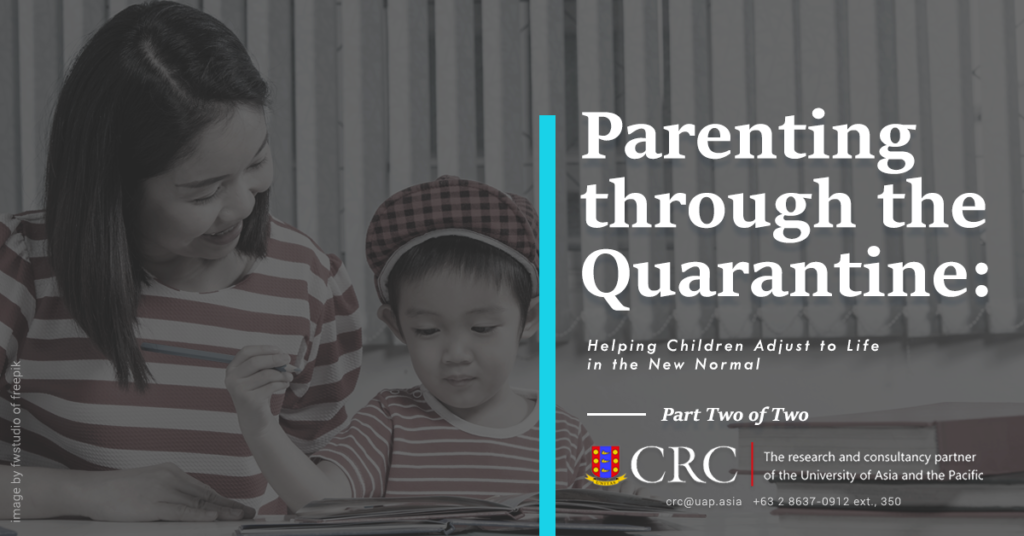In part one of our two-part interview with the staff of the University of Asia and the Pacific’s Child Development and Education (CDE) Center about several issues related to COVID- 19, including how parents can prepare their kids emotionally for the upcoming “new normal”; how parents should adjust their approach in explaining the quarantine to kids of different ages; and how parents can more freely talk to their kids about their feelings regarding the disease.
 In this week’s conclusion to our two-part interview, we talk to CDE Center Director Ms. Lexie Estacio and Teachers Joey Santos, Audrey Madrilejos, Ena Guevarra, Nina Reyes, and Mel Garcia about knowing when one’s kids are having emotional difficulties about the quarantine, preparing schoolchildren for the transition back to school, and preparing kids if ever the family decides to make some post-quarantine adjustments to their living situation and lifestyle.
In this week’s conclusion to our two-part interview, we talk to CDE Center Director Ms. Lexie Estacio and Teachers Joey Santos, Audrey Madrilejos, Ena Guevarra, Nina Reyes, and Mel Garcia about knowing when one’s kids are having emotional difficulties about the quarantine, preparing schoolchildren for the transition back to school, and preparing kids if ever the family decides to make some post-quarantine adjustments to their living situation and lifestyle.
This article covers part two of the interview. The first part can be accessed here. Meanwhile, some closing words of encouragement from the staff of the UA&P CDE Center are here.
CRC would like to acknowledge the help of IMFD staffer Ms. Mikha Gatpandan and the CDE Center’s Ms. Lexie Estacio, without whom this interview would not have been possible.
- Kids are usually good at hiding it, but is there a way to tell if a schoolchild is having difficulty addressing their emotions about the quarantine? If a parent suspects this is the case with their child, what should they try to do?
Teacher Aubrey Madridejos
A change of emotions and behavior during these times of pandemic is normal to both adults and children. There are times that it is hard to express one’s emotion, especially when there are many uncertainties around us.
In my class, whenever I see my students feeling upset or having negative emotions, I would ask the child privately about what he or she is feeling.
I make sure that when I talk with the child, he or she is not in front of his/her classmates – so that he/she would not feel bad or feel ashamed. However, if the child does not want to speak to me at the moment, I would ask the child if I could give him/her a few minutes to think and then we would talk. Sometimes we just need some time to think about our emotions before we could express it to others.
But there are other children who prefer to keep his/her emotions to himself/herself. This is when the “processing” part takes in. The adult would try to probe with questions that may lead to the child telling his/her emotions. However, the parent must not bombard the child with lots of questions and it has to be said and phrased in a positive manner. The child may shy away, if he/she feels threatened with questions.
Teacher Joey Santos
Adapting to new situations and transitioning to new routines naturally leads to a change in behavior and mood in young children.
Some children may cope well but being irritable and moody can be common as they struggle to adapt with the changes. Parents must listen and talk to their children to understand how they feel and help them process negative emotions.
They can also provide different activities such as family play time, reading stories, or making art – that can serve as an outlet for children to release their energy. It is also important that children feel that they are safe and loved amidst this threatening and difficult situation.
Teacher Nina Reyes
When children are experiencing a big transition, it is common for them to display changes in behavior.
For instance, parents may notice their children being more territorial or possessive of their toys, learning expressions that they do not usually say, throwing tantrums more frequently, or being more quiet or active than usual. (However, it is still important to remember that children express their emotions differently.)
When this happens, parents must take time to communicate with their children, ask about why they are behaving that way, and reassure them that despite how difficult the situation is now, they are still safe and loved.
We must always make the children feel that their emotions are valid, and that they have someone to share them with whenever they are ready.
Ms. Lexie Estacio
Parents’ presence at this time is very important. […]
The key is to be observant of their children’s feelings or reactions to the pandemic.
If they notice that their child is having a difficult time adjusting or understanding what’s happening, they should find ways for the child to have an emotional outlet.
Teacher Ena Guevarra
Parents should never lose sight of communication and to an extent, be sensitive of how a child is feeling.
Empathizing is very important at this time. If communicating won’t make the child open up, at least the parent should “feel” what his/her child is feeling at the moment is enough.
Children may express him/her self in other forms such as tantrums, misbehaviors, etc. but even still, parents should always be there to reassure their child and are always ready to help.
Teacher Mel Garcia
Emotional and behavioral changes are highly probable under the extraordinary circumstances we are in, as everyone adjusts to the new set up. The presence of a sensitive and responsive caregiver is crucial.
Parents should be perceptive to, or on the lookout for ongoing patterns in the child’s demeanor and attitude. Talking to the child — acknowledging their emotions, helping in identifying these and their causes, and giving reassurance that the parents are there to help and keep them safe — may aid the child. Should patterns still persist, professional help may be sought. To mitigate such effects, it is best to spend quality time with the children as much as possible.
- How about the emotional stress of going back to a school environment? Some kids are looking forward to going back, while some of them dread the idea. What should parents say to the kids who aren’t eager to return?
Ms. Lexie Estacio
The preparation should be taking place even at this point when we are still unsure of when school will resume. Talking about going back to school from time to time will help prepare the child. […]
Teacher Mel Garcia
Highlight the aspects that the child anticipates and enjoys in school to stir his/her enthusiasm for school (e.g. spending time and catching up with classmates, playing in the playground, reading in the library, etc.).
Parents will have to explain that staying at home for an extended period as an effect or the pandemic is just temporary; that everything will be back to normal.
Children are creatures of habit. Building and maintaining routines — keeping a schedule, incorporating school-like activities, regulating behavior by setting agreed rules, etc. — at home would help them prepare them for the back to school transition.
Teacher Aubrey Madridejos
Building the child’s routine at home is very important. Routine in a sense that they would still have study time or activity/play time during the week so that they would not be shocked when they have to go back to their school.
It is true, indeed that there are children who may not be too excited to go back to their school. Parents should highlight their child’s favorite thing in school – whether their favorite activity, toy, or even classmates/friends. It is a good reminder to them that those activities, toys, and classmates are waiting for him/her.
Moreover, the parent should also reassure the child that he/she is not alone when he/she goes back to school. Their friends and their teachers are ready to welcome him/her with open arms.
Teacher Joey Santos
For children who are anxious about returning, parents must talk to them and remind them of all the things they love about school – playing with their friends, seeing their teacher, reading new books, or getting their favorite ice cream after class. Remembering their fondness of school will harbour positive emotions and will help children look forward to coming back. :)
Teacher Ena Guevarra
I hope that parents will not get tired of talking to their child and processing emotions in this time of pandemic.
Going back to school from this situation may be a big transition to kids and might experience separation anxiety once in school. Reassurance and communication are keys to help the child overcome his/her fears.
- Some parents have used the quarantine as an opportunity to rethink some of their choices, and have decided to make some big changes after the quarantine is over. Is there anything parents can do to help these children deal with even more changes?
Teacher Nina Reyes
Communication is key. The COVID-19 situation has already been life-changing for us as we all had to adjust and take a break from our normal routines.
Before they implement even more changes, parents must first pause and explain these to their children. They must be ready to answer all their questions honestly and in a manner that is easy for them to understand.
Ms. Lexie Estacio
Gradual transition is important. Parents should not surprise the child with sudden changes or routines. They should always be on the lookout for the child’s emotions or reactions to new routines or practices.
If the child is responding negatively to the changes, the parents must patiently process the situation with the child.
They should be sensitive, and they should listen to what the child is communicating.
It is more challenging if the child is not very expressive of his thoughts and emotions. The parents have to find ways to discover and understand what causes the child to respond negatively to the changes and address them immediately.
Teacher Ena Guevarra
Parents must always be ready to answer questions of their child and ready to attend to the needs. It is important to always check up on their child and [put themselves in] the shoes of the child.
Teacher Joey Santos
Whether changes are big or small, it is best for parents to communicate about it with their children. Leaping into big changes is a family affair and thus must be dealt with together.
Parents must prepare children for the changes by informing them about it, explaining why it has to happen, asking them how they feel, and if possible, involve them in decision-making.
This will make children feel respected and in effect, help children respect their parents’ decisions. Feeling that they are part of the decision will help them accept the changes it comes with.
In part I of this interview, which can be accessed here, we discuss how to tell if a schoolchild is having difficulty addressing their emotions about the quarantine; what should parents say to the kids who aren’t eager to return to a school environment; and the UA&P SED teachers’ advice for parents still struggling to keep their kids engaged, even if they’re stuck in the house all day.






